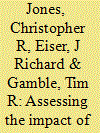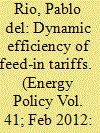|
|
|
Sort Order |
|
|
|
Items / Page
|
|
|
|
|
|
|
| Srl | Item |
| 1 |
ID:
111350


|
|
|
|
|
| Publication |
2012.
|
| Summary/Abstract |
The analysis of rural residential energy consumption in China from 2001 to 2008 and corresponding impacts on climate change is presented in the paper. It is found that rural residential energy consumption has shown obvious transition from non-commercial energy to commercial energy. The percentage of biomass energy consumption dropped from 81.5% in 2001 to 70.9% in 2008, while the percentage of commercial energy increased from 17.1% to 25.1%. Besides, other renewable energy increased very fast with annual growth rate of 19.8%. Correspondingly, total CO2 emissions from rural residential energy consumption had significant increase from 152.2 Million tons in 2001 to 283.6 Million tons in 2008. The annual growth rate of per capita CO2 emissions was nearly 2 times faster than that of urban area. The major driving force for the consumption of commercial energy was the income of rural farmers, while strong rural energy policies supported the development of renewable energy. To satisfy the goals of energy supply and CO2 emissions reduction in rural areas, it is advised to change the energy structure and improve the energy efficiency, such as to generate electricity using renewable technologies and to replace coal with modern biomass energy for cooking and heating.
|
|
|
|
|
|
|
|
|
|
|
|
|
|
|
|
| 2 |
ID:
111360


|
|
|
|
|
| Publication |
2012.
|
| Summary/Abstract |
Wind farms are becoming increasingly popular in Ireland in an effort to increase the production of green energy within the state. As with any infrastructural development, wind farms must consider potential environmental impacts prior to construction. One particular issue that must be examined is the emission of noise from the development. In Ireland wind farm developments must adhere to planning conditions that usually outline permissible noise levels for both the construction and operational phases of the development. The critical wind speed is often cited as the wind speed at which these limits apply. This paper examines how the critical wind speed is determined and investigates its relationship with background noise levels and turbine choice. The study consisted of ten one-week monitoring periods during which meteorological conditions and background noise levels were simultaneously recorded. It was found that the critical wind speed is non-transferable, i.e. it depends on both the turbine choice and background noise environment and is specific to that particular turbine/site combination. Furthermore the critical wind speed during the night-time is often different to the overall critical wind speed suggesting that future noise studies should consider a range of critical wind speeds, particularly for night-time noise assessments.
|
|
|
|
|
|
|
|
|
|
|
|
|
|
|
|
| 3 |
ID:
111351


|
|
|
|
|
| Publication |
2012.
|
| Summary/Abstract |
In 2007 the UK government's public consultation on the future of nuclear power courted much criticism. Three studies were conducted to assess whether key arguments used by government within this consultation might have influenced public opinion about the technology. Participants first read a passage of text that made salient certain positive (climate change mitigation, increased energy security) or negative (nuclear waste) aspects of the nuclear debate. Participants then completed a task that required them to create an electricity mix for the UK by varying the contributions made by each of five energy sources (coal, gas, nuclear, renewables and electric import). Study 1 seemed to indicate that pitching the debate in terms of climate change mitigation was effective in increasing endorsement of nuclear power. The results of studies 2 and 3, however, contested this conclusion, suggesting that these arguments were having little direct impact upon participants' preferences for nuclear power. The results of these studies hold implications for UK energy policy and attitude assessment and can contribute to the understanding of how the arguments used by government in the 2007 consultation might have influenced public opinion.
|
|
|
|
|
|
|
|
|
|
|
|
|
|
|
|
| 4 |
ID:
111394


|
|
|
|
|
| Publication |
2012.
|
| Summary/Abstract |
For more than a decade, Nobel laureate George Olah and coworkers have advocated the Methanol Economy - replacing petroleum-based fuels and chemicals with methanol and methanol-derivatives - as a path to sustainable development. A first step to this vision appears to be occurring in China. In the past five years, China has quickly built an industry of coal-based methanol and dimethyl ether (DME) that is competitive in price with petroleum-based fuels. Methanol fuels offer many advantages, including a high octane rating and cleaner-burning properties than gasoline. Methanol also has some disadvantages. A coal-based Methanol Economy could enhance water shortages in China, increase net carbon dioxide emissions, and add volatility to regional and global coal prices. China's rapidly expanding Methanol Economy provides an interesting experiment for what could happen elsewhere if methanol is widely adopted, as proposed by Olah and researchers before him.
|
|
|
|
|
|
|
|
|
|
|
|
|
|
|
|
| 5 |
ID:
111376


|
|
|
|
|
| Publication |
2012.
|
| Summary/Abstract |
This article examines consumer willingness to pay for energy-saving compact fluorescent light bulbs using the results of a stated preferences study conducted in the Caribbean island nation of Saint Lucia. Geographic location, low income status, and age are found to affect willingness-to-pay for compact fluorescent lighting, while higher income status and other demographic variables appear to have minimal or no significant impacts. Energy efficiency knowledge is associated with increased willingness-to-pay for energy-efficient bulbs and with increased use of compact fluorescent lighting. Contrary to theoretical expectations, past purchase of compact fluorescent bulbs is found to have no impact on self-reported willingness to pay. We hypothesize that this null result is due to the recent emergence of low-cost, low-quality compact fluorescent bulbs in the Saint Lucian lighting market, which may be negatively influencing consumers' preferences and expectations regarding energy-efficient lighting. Findings support the argument that government-sponsored education and subsidy programs will likely result in increased use of energy-saving technologies in Saint Lucia. But such behavioral changes may not be sustained in the long run unless low quality bulbs - the "lemons" of the compact fluorescent lighting market - can be clearly identified by consumers.
|
|
|
|
|
|
|
|
|
|
|
|
|
|
|
|
| 6 |
ID:
111387


|
|
|
|
|
| Publication |
2012.
|
| Summary/Abstract |
Offshore wind power is anticipated to make a major contribution to the UK's renewable energy targets but, contrary to expectations, costs have risen dramatically in recent years. This paper considers the context of these cost increases, and describes a disaggregated levelised cost model used by the authors to explore the effect of different assumptions about the direction and scale of the major cost drivers. The paper identifies the competing upward and downward pressures on costs in the medium term, and discusses the range of future costs that emerges from the analysis. The paper goes on to analyse the implications of these cost projections for the policy support levels that offshore wind may require. The paper suggests that there are good reasons why it is reasonable to expect a gradual fall in costs in the period to the mid-2020s, although it is unlikely that costs will fall as rapidly as they have risen, or that it will be a smooth downward trajectory. A key challenge is to reconcile the scale and pace of development desired for UK offshore wind with the potential growth rate that the supply chain can sustain without creating upward pressure on costs.
|
|
|
|
|
|
|
|
|
|
|
|
|
|
|
|
| 7 |
ID:
111349


|
|
|
|
|
| Publication |
2012.
|
| Summary/Abstract |
Over the next decade, large energy investments are required in the UK to meet growing energy service demands and legally binding emission targets under a pioneering policy agenda. These are necessary despite deep mid-term (2025-2030) uncertainties over which national policy makers have little control. We investigate the effect of two critical mid-term uncertainties on optimal near-term investment decisions using a two-stage stochastic energy system model.
The results show that where future fossil fuel prices are uncertain: (i) the near term hedging strategy to 2030 differs from any one deterministic fuel price scenario and is structurally dissimilar to a simple 'average' of the deterministic scenarios, and (ii) multiple recourse strategies from 2030 are perturbed by path dependencies caused by hedging investments. Evaluating the uncertainty under a decarbonisation agenda shows that fossil fuel price uncertainty is very expensive at around £20 billion. The addition of novel mitigation options reduces the value of fossil fuel price uncertainty to £11 billion. Uncertain biomass import availability shows a much lower value of uncertainty at £300 million.
This paper reveals the complex relationship between the flexibility of the energy system and mitigating the costs of uncertainty due to the path-dependencies caused by the long-life times of both infrastructures and generation technologies.
|
|
|
|
|
|
|
|
|
|
|
|
|
|
|
|
| 8 |
ID:
111382


|
|
|
|
|
| Publication |
2012.
|
| Summary/Abstract |
Jatropha, a non-edible oil seed yielding plant has been identified by the Government of India to produce biodiesel under National Biodiesel Mission. Failure of phase-I of National Biodiesel Mission and likely failure of phase-II requires critical analysis of policy frameworks related to its long term sustainability. Indian biofuel promotion policies like Biodiesel Purchase Policy and National Biofuel Policy have failed to yield any visible results. No tangible ground work is visible as of now to ensure success of various government plans and policies related to adoption of jatropha biodiesel. It is clearly evident that some serious bottlenecks are delaying the adoption of jatropha biodiesel. Present work identifies important policy bottlenecks like availability of land, non-remunerative pricing policy and state fear relating to loss of revenue in the case of zero duty regimes. This paper attempts to explore and critically analyze present policies and possible options taking into account the recent Indian experiences for successful adoption of jatropha biodiesel.
|
|
|
|
|
|
|
|
|
|
|
|
|
|
|
|
| 9 |
ID:
111326


|
|
|
|
|
| Publication |
2012.
|
| Summary/Abstract |
The main object of this paper consists in the development of a mathematical closed-form expression for the evaluation, in the period 2010-2050, of the levelized costs of energy (LCOE) of concentrating solar power (CSP) electricity. For this purpose, the LCOE is calculated using a life-cycle cost method, based on the net present value, the discounted cash flow technique and the technology learning curve approach. By this procedure, the LCOE corresponding to CSP electricity is calculated as a function of ten independent variables. Among these parameters, special attention has been put on the evaluation of the available solar resource, the analysis of the IEA predicted values for the cumulative installed capacity, the initial (2010) cost of the system, the discount and learning rates, etc. One significant contribution of our work is that the predicted evolution of the LCOEs strongly depend, not only on the particular values of the cumulative installed capacity function in the targeted years, but mainly on the specific curved time-paths which are followed by this function. The results obtained in this work are shown both graphically and numerically. Finally, the implications that the results could have in energy planning policies and grid parity calculations are discussed.
|
|
|
|
|
|
|
|
|
|
|
|
|
|
|
|
| 10 |
ID:
111348


|
|
|
|
|
| Publication |
2012.
|
| Summary/Abstract |
Energy policy depends on a proper use of methodology in guiding a large energy issue such as the global warming and climate change. DEA is one of such methodologies that are often used for preparing environmental policy, which is closely linked to various energy issues. Unfortunately, the use of DEA applied to environmental policy is insufficient, often misguiding policy makers and other individuals who are involved in energy issues. This study provides three guidelines for a use of DEA in preparing environmental assessment. First, it is important to prepare both primal and dual formulations to confirm whether information regarding all production factors (i.e., inputs, desirable and undesirable outputs) is fully utilized in DEA assessment. Second, DEA has model variations in radial and non-radial measurements. It is necessary for us to examine environmental issues by different models in order to avoid a methodological bias existing in those empirical studies. Finally, DEA environmental assessment needs to incorporate the concept of natural and managerial disposability. The natural disposability indicates that a firm negatively adapts a regulation change on undesirable outputs. In contrast, the managerial disposability indicates that a firm positively adapts the regulation change because the firm considers the regulation change as a new business opportunity.
|
|
|
|
|
|
|
|
|
|
|
|
|
|
|
|
| 11 |
ID:
111318


|
|
|
|
|
| Publication |
2012.
|
| Summary/Abstract |
Between 1989 and 2004, energy consumption for road freight in the UK is estimated to have increased by only 6.3%. Over the same period, UK GDP increased by 43.3%, implying that the aggregate energy intensity of UK road freight fell by 25.8%. During this period, therefore, the UK achieved relative but not absolute decoupling of road freight energy consumption from GDP. Other measures of road freight activity, such as tonnes lifted, tonnes moved, loaded distance travelled and total distance travelled also increased much slower than GDP. The main factor contributing to the observed decoupling was the declining value of manufactured goods relative to GDP. Reductions in the average payload weight, the amount of empty running and the fuel use per vehicle kilometre also appear to have made a contribution, while other factors have acted to increase aggregate energy intensity. The results demonstrate that the UK has been more successful than most EU countries in decoupling the environmental impacts of road freight transport from GDP. However, this is largely the unintended outcome of various economic trends rather than the deliberate result of policy.
|
|
|
|
|
|
|
|
|
|
|
|
|
|
|
|
| 12 |
ID:
111346


|
|
|
|
|
| Publication |
2012.
|
| Summary/Abstract |
The recently amended U.S. Corporate Average Fuel Economy (CAFE) standards determine fuel-economy targets based on the footprint (wheelbase by track width) of vehicles such that larger vehicles have lower fuel-economy targets. This paper considers whether these standards create an incentive for firms to increase vehicle size by presenting an oligopolistic-equilibrium model in which automotive firms can modify vehicle dimensions, implement fuel-saving technology features, and trade off acceleration performance and fuel economy. Wide ranges of scenarios for consumer preferences are considered. Results suggest that the footprint-based CAFE standards create an incentive to increase vehicle size except when consumer preference for vehicle size is near its lower bound and preference for acceleration is near its upper bound. In all other simulations, the sales-weighted average vehicle size increases by 2-32%, undermining gains in fuel economy by 1-4 mpg (0.6-1.7 km/L). Carbon-dioxide emissions from these vehicles are 5-15% higher as a result (4.69×1011-5.17×1011 kg for one year of produced vehicles compared to 4.47×1011 kg with no size changes), which is equivalent to adding 3-10 coal-fired power plants to the electricity grid each year. Furthermore, results suggest that the incentive is larger for light trucks than for passenger cars, which could increase traffic safety risks.
|
|
|
|
|
|
|
|
|
|
|
|
|
|
|
|
| 13 |
ID:
111383


|
|
|
|
|
| Publication |
2012.
|
| Summary/Abstract |
This paper uses a series of interviews to investigate how municipal planners in three Canadian provinces (Nova Scotia, Quebec, and Ontario) influence setbacks that regulate appropriate locations for wind turbines. Setbacks are provisions in local land use policies that dictate required separation distances between wind turbines and other land uses. Results of the study indicate that planners are not using a consistent method to ascertain appropriate distances and are often constrained by a lack of experience, resources, and expertise. These findings have important implications for wind energy regulation. Setbacks are intended to reasonably protect the public from the impacts of wind turbines, while allowing for some development. Municipalities in Canada may be best placed to consider local impacts of wind power, but the challenges identified raise concerns about potential arbitrariness. Setbacks that are unjustifiably high can unnecessarily close off territory and limit the ability to reach renewable energy targets. Taking regulatory power away from municipalities, as has happened in Ontario, can facilitate achievement of provincial targets, but may also increase opposition to projects at the local level.
|
|
|
|
|
|
|
|
|
|
|
|
|
|
|
|
| 14 |
ID:
111332


|
|
|
|
|
| Publication |
2012.
|
| Summary/Abstract |
The world is facing the severe challenges of energy depletion and carbon dioxide (CO2) emissions, and solar energy is considered to be a promising source of renewable energy and effective solution. However, the application of solar energy is limited in practice due to various barriers. Based on data collected from a survey of practice, this paper identifies the key barriers to the deployment of solar photovoltaic (PV) energy systems in Hong Kong. These include "high initial and repair cost", "long payback period", "inadequate installation space and service infrastructure", "lack of participation of stakeholders/community in energy policy" and "lack of incentives by legislation and regulation". Recommendations for addressing these barriers are proposed. For example, the high cost of solar PV energy systems can be reduced by the development and mass production of low-cost fabrication technologies and high performance PV technologies. Solar thermal applications should be encouraged as they are much more economical than solar PVs. It is also recommended that the Hong Kong Government adopt strategies to encourage a greater use of solar energy systems. The results from this study not only provide useful information for the Government, the private sector and consumers in Hong Kong but are also likely to apply equally to other similar regions around the world.
|
|
|
|
|
|
|
|
|
|
|
|
|
|
|
|
| 15 |
ID:
111317


|
|
|
|
|
| Publication |
2012.
|
| Summary/Abstract |
This paper1 takes as its starting point the observation that fuel prices - and thus taxes - are important for good management of climate change and other environmental problems. To economists this should be no surprise yet it seems that the role of fuel taxation as an instrument of climate policy has not been fully appreciated. It is however one of the few policy instruments that, since several decades, has actually reduced fuel consumption appreciably. Thanks to taxation (mainly in Europe and Japan), carbon emissions are considerably lower than they would have been otherwise. In future where carbon emissions are to be cut drastically, this instrument will be crucial. There is however much opposition to the instrument. This opposition uses various arguments, for instance that fuel taxes hurt the poor since they are strongly regressive. We however find that the choice of country and methodology turns out to be of great consequence. We study seven European countries-France, Germany, United Kingdom, Italy, Serbia, Spain and Sweden and do find some evidence of regressivity but the evidence is very weak. It does not apply when lifetime income is used and it does not apply to the poorest country in the group. The best one-line summary is probably that the tax is approximately proportional.
|
|
|
|
|
|
|
|
|
|
|
|
|
|
|
|
| 16 |
ID:
111323


|
|
|
|
|
| Publication |
2012.
|
| Summary/Abstract |
There is an ongoing discussion if it is reasonable to start using nuclear energy, to extend its use, or what effects its phase out could have. In July 2011, four months after the nuclear accidents in Japan, Germany decided to return to the policy of phasing out nuclear energy step by step until 2022. This policy was already decided upon in 2000. With this, a decision made some nine months earlier was taken back. In fall 2010, the government and Parliament had approved the extension of the operating lives of its nuclear plants by at least 14 years. One reason was the expected effect on the electricity price, which was said to be lower with extended nuclear plant life spans.
However, there is an ongoing debate on this argument, not only in Germany. This article presents a critical survey of the core arguments brought forward in favour of expected future price cuts. It is shown that the theoretical electricity market models used in these exercises are not adequate to reliably predict such effects. Furthermore, evidence is presented suggesting that extending nuclear plant life spans or the commissioning of new reactors in other countries is unlikely to curb domestic electricity prices.
|
|
|
|
|
|
|
|
|
|
|
|
|
|
|
|
| 17 |
ID:
111370


|
|
|
|
|
| Publication |
2012.
|
| Summary/Abstract |
This paper discusses domestic energy use and energy behaviour. It shows some improvement in domestic energy consumption and adoption of good energy practice. The survey conducted indicated that 35% of homes could improve their energy efficiency by improved tank insulation. In the last 5 years condensing boilers have been installed only in 3% of homes, indicating that householders are unaware of their advantages. Although 88% of surveyed homes had purchased a major appliance in the last 2 years, only 16% had any idea of the energy rating of their new appliances. Use of energy saving light bulbs is predominant in kitchens compared to other rooms. 70-80% of householders undertook some kind of day-to-day energy efficiency measures. 20-35% of householders would like to invest in energy-saving measures but found cost to be a key barrier. Approximately 84% of those surveyed were unaware of the energy rating of their household appliances. Price and brand were the most important factors determining the purchase of a new appliance. Significant energy-saving could be achieved by providing appropriate information to the general public regarding temperature control, efficiency of appliances and energy-saving heating systems.
|
|
|
|
|
|
|
|
|
|
|
|
|
|
|
|
| 18 |
ID:
111322


|
|
|
|
|
| Publication |
2012.
|
| Summary/Abstract |
Dynamic efficiency has received much less attention than the effectiveness and static efficiency criteria to assess policies to support electricity from renewable energy sources (RES-E). On the other hand, the literature on RES-E support shows that the choice of design elements within RES-E support instruments is at least as important to successfully promote RES-E as the choice of specific instruments. The aim of this paper is to build a theoretical framework for dynamic efficiency analysis and assess the dynamic efficiency properties of the different design elements of feed-in tariffs. It is shown that, in fact, several design elements can have a significant impact on the different dimensions of dynamic efficiency. Particularly relevant design elements in this context are technology-specific fixed-tariffs, floor prices, degression, reductions of support over time for existing plants, long duration of support and support falling on consumers. In addition, it is shown than some design elements would be more appropriate than others to activate specific dimensions.
|
|
|
|
|
|
|
|
|
|
|
|
|
|
|
|
| 19 |
ID:
111340


|
|
|
|
|
| Publication |
2012.
|
| Summary/Abstract |
Based on recent research showing that hydrogen enrichment can lower NOx emissions from landfill gas combustion below future NOx emission control standards imposed by both federal and California state regulations, an investigation was performed to compare the levelized cost of electricity of this technology with other options. In this cost study, a lean-burn reciprocating engine with no after-treatment was the baseline case to compare six other landfill gas-to-energy projects. These cases include a lean burn engine with selective catalytic reduction after treatment, a lean-burn microturbine, and four variations on an ultra-lean-burn engine utilizing hydrogen enrichment with each case using a different method of hydrogen production. Only hydrogen enrichment with an in-stream autothermal fuel reformer was shown to be potentially cost-competitive with current strategies for reaching the NOx reduction target in IC engines.
|
|
|
|
|
|
|
|
|
|
|
|
|
|
|
|
| 20 |
ID:
111362


|
|
|
|
|
| Publication |
2012.
|
| Summary/Abstract |
Increasing energy use and the need to mitigate climate change make production of liquid biofuels a high priority. Farmers respond worldwide to this increasing demand by converting forests and grassland into biofuel crops, but whether biofuels offer carbon savings depends on the carbon emissions that occur when land use is changed to biofuel crops. This paper reports the results of a study on cassava-based bioethanol production undertaken in the Sikasso region in Southern Mali. The paper outlines the estimated impacts on above-ground carbon stocks when land use is changed to increase cassava production. The results show that expansion of cassava production for bioethanol will most likely lead to the conversion of fallow areas to cassava. A land use change from fallow to cassava creates a reduction in the above-ground carbon stocks in the order of 4-13 Mg C ha-1, depending on (a) the age of the fallow, (b) the allometric equation used and (c) whether all trees are removed or the larger, useful trees are preserved. This 'carbon debt' associated with the above-ground biomass loss would take 8-25 years to repay if fossil fuels are replaced with cassava-based bioethanol.
|
|
|
|
|
|
|
|
|
|
|
|
|
|
|
|
|
|
|
|
|